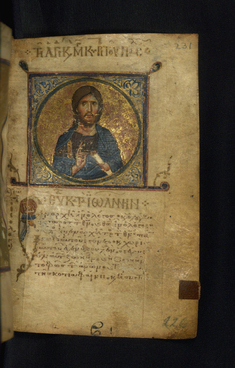Gospel Book
(Manuscripts and Rare Books)
This Gospel book was likely created in the capital of the Byzantine Empire, Constantinople, in the eleventh century. The manuscript is remarkable on account of its exceptionally small size, as well as the high quality of its script and miniatures. Its extensive image cycle includes six full-page miniatures, four half-page miniatures, four historiated initials, and marginalia.
Provenance
Provenance (from the French provenir, 'to come from/forth') is the chronology of the ownership, custody, or location of a historical object. Learn more about provenance at the Walters.
Henry Walters, Baltimore [date and mode of acquisition unknown]; Walters Art Museum, 1931, by bequest.
Exhibitions
| 2009 | Shrunken Treasures: Miniaturization in Books and Art. The Walters Art Museum, Baltimore. |
| 2004 | Illuminating the Word: Gospel Books in the Middle Ages. The Walters Art Museum, Baltimore. |
| 1986 | Byzantine Gold: Illumination in Greek Manuscripts. The Walters Art Gallery, Baltimore. |
| 1973 | Illuminated Greek Manuscripts from American Collections; An Exhibition in Honor of Kurt Weitzmann. Princeton University Art Museum, Princeton. |
| 1947 | Early Christian and Byzantine Art. Baltimore Museum of Art, Baltimore. |
Conservation
| Date | Description | Narrative |
|---|---|---|
| 4/8/1986 | Examination | examined for condition |
Geographies
Constantinople
(Place of Origin)
Byzantium (Place of Binding)
Measurements
Overall H: 4 3/16 x W: 3 7/16 x D: 2 1/16 in. (10.7 x 8.7 x 5.2 cm); Folio H: 3 7/8 × W: 2 5/8 in. (9.9 × 6.7 cm)
Credit Line
Acquired by Henry Walters
Location in Museum
Not on view
Accession Number
In libraries, galleries, museums, and archives, an accession number is a unique identifier assigned to each object in the collection.
In libraries, galleries, museums, and archives, an accession number is a unique identifier assigned to each object in the collection.
W.522



